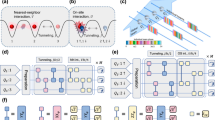Abstract
Near-term quantum computers provide a promising platform for finding the ground states of quantum systems, which is an essential task in physics, chemistry and materials science. However, near-term approaches are constrained by the effects of noise, as well as the limited resources of near-term quantum hardware. We introduce neural error mitigation, which uses neural networks to improve estimates of ground states and ground-state observables obtained using near-term quantum simulations. To demonstrate our method’s broad applicability, we employ neural error mitigation to find the ground states of the H2 and LiH molecular Hamiltonians, as well as the lattice Schwinger model, prepared via the variational quantum eigensolver. Our results show that neural error mitigation improves numerical and experimental variational quantum eigensolver computations to yield low energy errors, high fidelities and accurate estimations of more complex observables such as order parameters and entanglement entropy without requiring additional quantum resources. Furthermore, neural error mitigation is agnostic with respect to the quantum state preparation algorithm used, the quantum hardware it is implemented on and the particular noise channel affecting the experiment, contributing to its versatility as a tool for quantum simulation.
This is a preview of subscription content, access via your institution
Access options
Access Nature and 54 other Nature Portfolio journals
Get Nature+, our best-value online-access subscription
$29.99 / 30 days
cancel any time
Subscribe to this journal
Receive 12 digital issues and online access to articles
$119.00 per year
only $9.92 per issue
Buy this article
- Purchase on Springer Link
- Instant access to full article PDF
Prices may be subject to local taxes which are calculated during checkout



Similar content being viewed by others
Data availability
The experimental and numerical quantum simulation measurement data shown in Fig. 2 for H2 and LiH, as well as the measurement data used in Fig. 3a–d for the eight-site lattice Schwinger model, are available at https://github.com/1QB-Information-Technologies/NEM (see Zenodo repository50).
Code availability
The numerical implementation of the NEM and the code used to numerically implement the quantum simulations studied here are available at https://github.com/1QB-Information-Technologies/NEM (see Zenodo repository50).
References
Feynman, R. P. Simulating physics with computers. Int. J. Theor. Phys. 21, 467–488 (1982).
Bennett, C. H. Logical reversibility of computation. IBM J. Res. Dev. 17, 525–532 (1973).
Benioff, P. The computer as a physical system: a microscopic quantum mechanical Hamiltonian model of computers as represented by Turing machines. J. Stat. Phys. 22, 563–591 (1980).
Manin, Y. Computable and Noncomputable (in Russian) (Sovetskoye Radio, 1980).
Preskill, J. Simulating quantum field theory with a quantum computer. In Proc. 36th Annual International Symposium on Lattice Field Theory (LATTICE2018) 334 (East Lansing, MI, USA, 2018).
Cao, Y. et al. Quantum chemistry in the age of quantum computing. Chem. Rev. 119, 10856–10915 (2019).
McArdle, S., Endo, S., Aspuru-Guzik, A., Benjamin, S. C. & Yuan, X. Quantum computational chemistry. Rev. Mod. Phys. 92, 015003 (2020).
Bauer, B., Bravyi, S., Motta, M. & Kin-Lic Chan, G. Quantum algorithms for quantum chemistry and quantum materials science. Chem. Rev. 120, 12685–12717 (2020).
Aspuru-Guzik, A., Dutoi, A. D., Love, P. J. & Head-Gordon, M. Simulated quantum computation of molecular energies. Science 309, 1704–1707 (2005).
Bharti, K. et al. Noisy intermediate-scale quantum algorithms. Rev. Mod. Phys. 94, 015004 (2022).
Cerezo, M. et al. Variational quantum algorithms. Nat. Rev. Phys. 3, 625–644 (2021).
Peruzzo, A. et al. A variational eigenvalue solver on a photonic quantum processor. Nat. Commun. 5, 4213 (2014).
Endo, S., Cai, Z., Benjamin, S. C. & Yuan, X. Hybrid quantum-classical algorithms and quantum error mitigation. J. Phys. Soc. Jpn 90, 032001 (2021).
Roffe, J. Quantum error correction: an introductory guide. Contemp. Phys. 60, 226–245 (2019).
Dunjko, V. & Briegel, H. J. Machine learning & artificial intelligence in the quantum domain: a review of recent progress. Rep. Progr. Phys. 81, 074001 (2018).
Carrasquilla, J. Machine learning for quantum matter. Adv. Phys. X 5, 1797528 (2020).
Torlai, G. et al. Neural-network quantum state tomography. Nat. Phys. 14, 447–450 (2018).
Becca, F. & Sorella, S. Quantum Monte Carlo Approaches for Correlated Systems (Cambridge Univ. Press, 2017).
Vaswani, A. et al. Attention is all you need. In Proc. 31st Conference on Neural Information Processing Systems (NIPS 2017) (Long Beach, CA, USA, 2017).
Cai, Z. Multi-exponential error extrapolation and combining error mitigation techniques for NISQ applications. npj Quantum Inf. 7, 80 (2021).
Torlai, G. et al. Integrating neural networks with a quantum simulator for state reconstruction. Phys. Rev. Lett. 123, 230504 (2019).
Song, C. et al. Quantum computation with universal error mitigation on a superconducting quantum processor. Sci. Adv. 5, eaaw5686 (2019).
Sun, J. et al. Mitigating realistic noise in practical noisy intermediate-scale quantum devices. Phys. Rev. Appl. 15, 034026 (2021).
Torlai, G., Mazzola, G., Carleo, G. & Mezzacapo, A. Precise measurement of quantum observables with neural-network estimators. Phys. Rev. Res. 2, 022060 (2020).
Assaraf, R. & Caffarel, M. Zero-variance principle for Monte Carlo algorithms. Phys. Rev. Lett. 83, 4682 (1999).
Kandala, A. et al. Hardware-efficient variational quantum eigensolver for small molecules and quantum magnets. Nature 549, 242–246 (2017).
Kokail, C. et al. Self-verifying variational quantum simulation of lattice models. Nature 569, 355–360 (2019).
Klco, N. et al. Quantum-classical computation of Schwinger model dynamics using quantum computers. Phys. Rev. A 98, 032331 (2018).
Martinez, E. A. et al. Real-time dynamics of lattice gauge theories with a few-qubit quantum computer. Nature 534, 516–519 (2016).
Borzenkova, O. V. et al. Variational simulation of Schwinger's Hamiltonian with polarization qubits. Appl. Phys. Lett. 118, 144002 (2021).
Brydges, T. et al. Probing Renyi entanglement entropy via randomized measurements. Science 364, 260–263 (2019).
Islam, R. et al. Measuring entanglement entropy in a quantum many-body system. Nature 528, 77–83 (2015).
Huembeli, P. & Dauphin, A. Characterizing the loss landscape of variational quantum circuits. Quantum Sci. Technol. 6, 025011 (2021).
Park, C.-Y. & Kastoryano, M. J. Geometry of learning neural quantum states. Phys. Rev. Res. 2, 023232 (2020).
Bukov, M., Schmitt, M. & Dupont, M. Learning the ground state of a non-stoquastic quantum Hamiltonian in a rugged neural network landscape. SciPost Phys. 10, 147 (2021).
Hochreiter, S. & Schmidhuber, J. Long short-term memory. Neur. Comput. 9, 1735–1780 (1997).
Hibat-Allah, M., Ganahl, M., Hayward, L. E., Melko, R. G. & Carrasquilla, J. Recurrent neural-network wavefunctions. Phys. Rev. Res. 2, 023358 (2020).
Sharir, O., Levine, Y., Wies, N., Carleo, G. & Shashua, A. Deep autoregressive models for the efficient variational simulation of many-body quantum systems. Phys. Rev. Lett. 124, 020503 (2020).
Carrasquilla, J. et al. Probabilistic simulation of quantum circuits using a deep-learning architecture. Phys. Rev. A 104, 032610 (2021).
Kingma, D. P. & Ba, J. Adam: a method for stochastic optimization. Preprint at https://arxiv.org/abs/1412.6980 (2014).
Carleo, G. & Troyer, M. Solving the quantum many-body problem with artificial neural networks. Science 355, 602–606 (2017).
Choo, K., Mezzacapo, A. & Carleo, G. Fermionic neural-network states for ab-initio electronic structure. Nat. Commun. 11, 2368 (2020).
Otis, L. & Neuscamman, E. Complementary first and second derivative methods for ansatz optimization in variational Monte Carlo. Phys. Chem. Chem. Phys. 21, 14491–14510 (2019).
Bravyi, S. B. & Kitaev, A. Y. Fermionic quantum computation. Ann. Phys. 298, 210–226 (2002).
Seeley, J. T., Richard, M. J. & Love, P. J. The Bravyi–Kitaev transformation for quantum computation of electronic structure. J. Chem. Phys. 137, 224109 (2012).
Bravyi, S., Gambetta, J. M., Mezzacapo, A. & Temme, K. Tapering off qubits to simulate fermionic Hamiltonians. Preprint at https://arxiv.org/abs/1701.08213 (2017).
Qiskit Development Team. Qiskit: An Open Source Framework for Quantum Computation, ver. 0.23.0. https://qiskit.org (IBM, 2019).
Spall, J. C. Implementation of the simultaneous perturbation algorithm for stochastic optimization. IEEE Trans. Aerosp. Electron. Syst. 34, 817–823 (1998).
Krantz, P. et al. A quantum engineer’s guide to superconducting qubits. Appl. Phys. Rev. 6, 021318 (2019).
Bennewitz, E. R., Hopfmueller, F., Kulchytskyy, B., Carrasquilla, J. & Ronagh, P. 1QB-Information-Technologies/NEM: 1QB-Information-Technologies/Neural Error Mitigation. Zenodo https://doi.org/10.5281/zenodo.6466405 (2022).
Acknowledgements
E.R.B., F.H., B.K. and P.R. thank 1QBit for financial support. During part of this work, E.R.B. and F.H. were students at the Perimeter Institute and the University of Waterloo and received funding through Mitacs, and F.H. was supported through a Vanier Canada Graduate Scholarship. Research at the Perimeter Institute is supported in part by the Government of Canada through the Department of Innovation, Science and Economic Development and by the Province of Ontario through the Ministry of Colleges and Universities. E.R.B. was also supported by a scholarship through the Perimeter Scholars International programme. P.R. thanks M. Lazaridis and O. Lazaridis and Innovation, Science and Economic Development Canada for financial support. J.C. acknowledges support from the Natural Sciences and Engineering Research Council, a Canada Research Chair, the Shared Hierarchical Academic Research Computing Network, Compute Canada, a Google Quantum Research Award and the Canadian Institute for Advanced Research (CIFAR) AI chair programme. Resources used by J.C. in preparing this research were provided, in part, by the Province of Ontario, the Government of Canada through CIFAR and companies sponsoring the Vector Institute (www.vectorinstitute.ai/#partners). P.R. thanks C. Muschik for useful conversations. We thank M. Bucyk for carefully reviewing and editing the manuscript.
Author information
Authors and Affiliations
Contributions
E.R.B. and F.H. developed the codebase for all studies, performed numerical experiments and analysed the results. E.R.B. performed experiments using the IBM quantum processor. E.R.B. and F.H. focused on the quantum chemistry and the lattice Schwinger model case studies, respectively. All authors contributed to ideation and dissemination. J.C. and P.R. contributed to the theoretical foundations and design of the method.
Corresponding author
Ethics declarations
Competing interests
The authors declare no competing interests.
Peer review
Peer review information
Nature Machine Intelligence thanks Alba Cervera-Lierta and the other, anonymous, reviewer(s) for their contribution to the peer review of this work.
Additional information
Publisher’s note Springer Nature remains neutral with regard to jurisdictional claims in published maps and institutional affiliations.
Extended data
Extended Data Fig. 1 VQE ansatz circuits for the lattice Schwinger model.
a, Variational quantum circuit used to prepare the approximate ground state of the lattice Schwinger model, using VQE simulated classically. The input state \(|{\Psi}_{0}\rangle\) is \(|01\cdots 01\rangle\) (\(|10\cdots 10\rangle\)) for m ≥ −0.7 (m < −0.7). b, For the results shown in Fig. 3e,f, the entangling layers of (a) are replaced with \({{{{\mathcal{O}}}}}_{N}\) for N sites. The layers of single-qubit gates are left unchanged.
Supplementary information
Supplementary Information
Supplementary Sections 1–8, Figs. 1–7 and Table 1.
Rights and permissions
About this article
Cite this article
Bennewitz, E.R., Hopfmueller, F., Kulchytskyy, B. et al. Neural Error Mitigation of Near-Term Quantum Simulations. Nat Mach Intell 4, 618–624 (2022). https://doi.org/10.1038/s42256-022-00509-0
Received:
Accepted:
Published:
Issue Date:
DOI: https://doi.org/10.1038/s42256-022-00509-0
This article is cited by
-
Variational Monte Carlo with large patched transformers
Communications Physics (2024)
-
Language models for quantum simulation
Nature Computational Science (2024)
-
HASM quantum machine learning
Science China Earth Sciences (2023)



